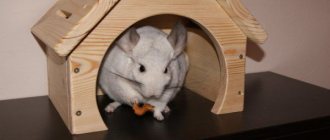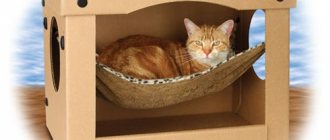Requirements for a hamster cage
A hamster cage is easy to make with your own hands, but you need to take into account the necessary parameters. The animal should have room in its new home.
First of all, you need to consider the size of the cage. In this case, the breed matters. The best option for a Djungarian hamster is housing measuring 50*40 cm. The height should be at least 20 cm.
There are different designs that you can make yourself:
- A good solution is a container for a hamster. At the same time, you should not be afraid that the animal will gnaw through the walls. There will be no problems with the arrangement of ventilation.
- The mink is made by analogy with the pet’s natural home. But this option is poorly ventilated.
- Aquariums also have some advantages, for example, sawdust will not fly in all directions and pets will not be able to get out easily, but such a container does not receive air in the required amount.
- From a ventilation point of view, the best solution is lattice cages. The grate can be made of rods.
Main settings
A cage for a hamster should, first of all, be spacious, comfortable, and must be equipped with various gaming accessories. The animals themselves like to divide their house into 3 main zones. Conventionally, they can be called as follows: bedroom, pantry and toilet, and all of them are equally important for a rodent.
When making a hamster cage with your own hands, take into account the smallest, seemingly insignificant details. After all, the health and life of your pet directly depends on how comfortable the house is. When considering the idea of a future home, use the following tips.
Dimensions
The most important parameter that must be taken into account when designing a house for a rodent is its size. The best option is when the width of the dwelling is 0.25 m and the length is 0.3 m. The height of the cage depends directly on the number of floors. The main thing is to maintain the same dimensions for all levels (not less than 0.25 m).
If you have a cage with bars, you need to choose the right frequency with which they will alternate. For a dwarf hamster, they should be spaced as often as possible so that he cannot crawl through and escape, and for a larger pet, at larger intervals.
Place for food
Pay attention to the arrangement of the food area. It is important that the cage has two of the most important attributes - a feeder and a drinking bowl for the animal.
It is most convenient to secure them in such a way that the baby cannot knock them over and at the same time, if necessary, easily reach both the food and the water.
Entertainment
The hamster is a very active and cheerful animal. If he does not have the opportunity to move freely around his home, he will begin to feel sad and may even get sick.
In order for the animal not to get bored and have fun, the house cannot be equipped with special entertainment accessories - a running wheel, a labyrinth, a ladder.
How to make a cage for a pet hamster with your own hands: step-by-step instructions
Now take a closer look at how to make a container for a hamster:
- Take the container and remove the lid from it. On the wrong side of the lid, draw a rectangle with dimensions of 45*15 cm. You can draw with a marker or felt-tip pen. Then the rectangle is cut out.
- Also cut out a piece measuring 50 by 20 cm from the mesh.
- Glue the mesh element on the back side. In this case, you can use superglue.
Additional work needs to be done on the existing structure. For example, pour shavings or special filler onto the bottom of the container. In this case, the thickness of the layer must be at least 5 cm. Housing must be built taking into account the needs of the permanent resident.
Making a house for a dzhungarik with your own hands
A hamster's house is his fortress, a refuge where he can sleep or hide. Animals sometimes need privacy too. If your financial situation is difficult, but you like to make things with your own hands, figure out how to make a house for a hamster from scrap materials.
The shelter can be made temporary (for 1-2 weeks) or permanent. But you need to know what you can use to make a safe and comfortable house for a hamster.
Paper and cardboard houses
The most budget option is to make a small booth out of cardboard. But how to make a cardboard house for a hamster with your own hands? There are several unusual options. Here are some of them:
- Cardboard box house. Very often, inventive owners make temporary furniture for pets from cardboard. The advantages of this method are simplicity and low cost. Disadvantage: fragility. Take an empty tissue box and carefully cut it across the oval hole. You will get 2 finished houses. Some owners make a round entrance for their furbabies by gluing a toilet paper roll to the recess on the box.
- Spacious house made from a tea bag. Nothing could be simpler: take an empty tea box and cut a round or rectangular hole in it. In such a shelter the animal will be pleased to sleep or store its treasures.
- Purchased cardboard house. Sold in stores. The cardboard is folded along the dotted lines and glued together using PVA.
If you have imagination and free time, you can design and make a paper house yourself. Entrust this activity to the children - they will definitely cope!
Plastic houses
Plastic is not the best option for building a hamster shelter. The hamster is a rodent, and plastic often contains toxins. But a plastic house is also suitable as a temporary room for a couple of days.
Here are some ideas:
- House made from a food container. Manufacturers make food storage containers from non-toxic materials, so they are suitable to become a hamster’s shelter for several days. It is enough to make an inlet hole and pierce the lid for better air circulation.
- Palace from a construction set. Kids willingly take part in arranging a hamster's life. A hamster will look very cool in a designer house. It can be made to any size and installed inside the climbing frame.
Wooden huts
The most beautiful houses for hamsters are made from wood. Here you can give free rein to your creative imagination, and involve the whole family in the process of creating a home. A small house is enough for one hamster, but if you have a family of small rodents, it is better to build them a wooden palace.
First of all, we make a drawing and apply dimensions. Then we cut out parts of the required size and shape from wood or plywood. Before assembly, you should drill holes for entry in the front wall of the house and sand it thoroughly with sandpaper. To prevent the air in your home from stagnating, do not forget about the windows (we also polish them). Assemble the house using small nails or special wood glue.
If the house is on the first floor of a cage, then you can make it with a staircase and a balcony. Your hamster will definitely love this apartment! And photos of pets in such a home are good enough for an exhibition!
The hut made from ice cream sticks looks very interesting. Even preschoolers can take part in the creation process! The main thing is to explain to them what needs to be done. Here are simple instructions:
- draw a plan for the future home;
- separately assemble 4 walls and a roof (from one or two parts);
- glue all parts together with wood glue.
And for teenagers who are interested in needlework, a more complex option is suitable. They can make a two-story hut with a ladder, an opening door and a window. This is very painstaking work, it develops perseverance and the desire to finish what you start. And a hamster in such a house will be able not only to sleep and hide, but also to do gymnastics.
Houses made from natural materials
Coconut houses for hamsters look charming. They are not only beautiful, but also useful. Khoma will sharpen her teeth and eat fiber at the same time.
You can drink healthy milk, scrape out and eat the pulp, and use the shell for construction. Drill two large holes (d = 5 cm): one is intended for stability, the other will serve as a door. Drill 4 holes on the side or on the side opposite the entrance - this is a ventilation window.
As you can see, making a house for a furry animal yourself is not so difficult. The main thing is desire, perseverance and a little imagination. For your diligence, the hamster will definitely thank you with his happy appearance!
What does a hamster need in a cage?
The hamster's home should be well equipped for its comfortable living.
Sleeping house
The cage should be equipped with a place for rest and privacy. The house in which the Syrian hamster will sleep can be made of various materials: plastic, wood, ceramics, wicker or cardboard. Rodents really like wooden products, but they have a disadvantage - wood absorbs odors well. Housing made of wicker or cardboard is quickly chewed by the pet.
It is best to opt for an inexpensive and practical plastic option. It is important that its size allows the hamster to fit and still has space for storage and a nest. The rodent should pass through the door freely, even with full cheek pouches. But the window should be small so that the animal can only stick its nose into it, or, conversely, spacious enough for free passage. Otherwise, the hamster may get stuck. For cleaning, it is convenient if the roof of the house is removed, but you should pay attention to ensure that such a removable roof is securely attached to the walls.
Filler
Various materials can be used as filler:
- Paper . It does not retain odor or moisture. If you still decide to go with paper filler, then it is better to use napkins, toilet paper or disposable handkerchiefs without fragrances. It is not recommended to use newspaper, as printing ink is harmful to hamsters who love to chew on everything.
- Sawdust . The most used filler option. It is inexpensive and retains odor and moisture, although not completely. But sawdust often gets tangled in the animal’s long fur and can injure the animal if it gets into the cheek pockets. They also contain wood dust, to which the animal may be allergic. Sawdust should be taken without a pronounced odor (not suitable for coniferous trees).
- Pressed . It is sold in the form of granules and is of better quality than sawdust. The pellets do not get tangled in fur and are safe, but also contain wood dust. Essentially, these are pressed sawdust, but they absorb odor and moisture almost 3 times better.
- Cellulose . Well suited for hamsters who are allergic to wood dust and sawdust, including pressed sawdust, is contraindicated. It is lighter and finer than wood filler.
- Corn . Absorbs moisture and odor best, hypoallergenic. Hamsters love to bask in it, so it often flies out of the cage. It is the smallest, lightest and most expensive.
Important! It is not recommended to use cotton wool or cloth as filler, as they are unsafe for hamsters. Animals can crush their paws with fibers. In addition, they do not retain moisture and odor well.
Feeder
The Syrian hamster often turns over things in the cage, so it is best to choose feeders that will be well secured to the bars of the cage.
Find out if you can give your hamster a banana.
You can also purchase weighted versions made of plastic, ceramic or metal. It is not recommended to buy glass items, as this rodent can break them and injure themselves from the fragments.
Drinking bowl
There are several types of drinkers, but the best one is the nipple one. A rodent can simply turn over an ordinary bowl and be left without water. And he can add filler to the bird's drinker according to the bird's principle. The hamster quickly learns to drink from the nipple automatic drinker; he will not turn it over or spill it, and will not throw anything inside. You can change the water in such a drinking bowl every few days, and not daily, as in other options.
Running wheel
Active rodents like Syrian hamsters should definitely buy a running wheel. Its diameter should be at least 18 cm, and the optimal dimensions are within 22–23 cm. It is better to choose a wheel with a mesh surface, since in the lattice design there is a risk of injuring the foot.
We recommend that you find out why you need a walking ball for a hamster.
The mesh should also be fairly fine to avoid injury. It is good if the wheel is attached to the bars of the cage, but if it is only on a stand, then the distance between it and the wheel should be at least 1 cm.
Mineral stone
It is necessary to take care of the rodent's teeth, which grow throughout its life. For this, it is best to purchase a mineral stone. It not only cares for the Syrian hamster’s teeth, but is also a source of useful elements for it. There are options that are attached to the bars of the cage.
If the animal is not interested in the mineral stone, you can offer it branches of fruit trees (cherry, pear, apple, etc.). The wood should not be treated with chemicals. It is enough to cut branches as thick as your little finger and about 5 cm long.
Important! The process of grinding teeth for a hamster is a vital necessity, because its teeth grow throughout its life and do not have roots. If grinding of the teeth does not occur, the incisors will injure the animal’s mouth, and this can even lead to death.
Toilet
Sooner or later you will notice that your hamster relieves itself in the same place. This is usually the corner of the cage away from the feeder. A tray with filler should be installed in it. To quickly get used to the toilet, you can first put already used litter with the animal’s feces into the litter.
The tray for a Syrian hamster should be quite spacious so that the animal can sit comfortably in it and relieve itself. Usually they buy a triangular or rectangular toilet with a length of 14–18 cm.
Types of cells
Today, pet stores offer a wide selection of different houses for rodents. However, their acquisition requires significant financial expenditure, and besides, not always the options that are available on the counter may be right for you. Before we tell you how to make a cage for a hamster with your own hands, let’s figure out what types of houses there are for fluffies.
- Standard cage. Such a house provides good access to the animal. If necessary, it will not be difficult for you to reach the hamster to get it out. This type of home is also convenient because it is easy to clean. In ordinary cages the animal feels quite comfortable. Through the bars he can easily interact with a person, and also use them in his games. The disadvantages of this type of cage include the fact that the baby may start gnawing on it. It also does not insulate from the noise produced by a rodent.
- Two-story and three-story housing. This type of cell differs from others in its dimensions. The floors can accommodate all the areas necessary for a pet’s comfortable stay. For example, on the lower floors you can arrange a play corner, and on the upper floors - a relaxation area.
- Aquarium or terrarium. The main advantage of such a house is that other animals (cat or dog) cannot reach the fluffy one. The disadvantages include the fact that such housing is quite difficult to clean, can be broken, and also has poor air ventilation.
- Mink house. This type of cage is very close to a hamster's natural habitat as it consists of plastic tunnels held together. Slippery plastic is not very suitable for the animal’s comfortable existence, and due to poor ventilation, an unpleasant odor appears in the house very quickly.
Advantages and disadvantages of racks and display cases for hamsters
Like any other type of housing for animals, a rack has its advantages and disadvantages.
- A clear advantage of making a display case yourself is the opportunity to save money: the cost of the rack will depend solely on the materials chosen.
- A homemade shelving unit can become not just a home for a pet, but an important element of the interior, since it can be made of any size, color, shape, and so on.
- A wooden rack will help hamsters wear down their teeth and bring them as close as possible to real life conditions in the wild.
- To make a rack with your own hands, you need to have basic woodworking skills, that is, be able to saw, sand, drill, and so on.
- Since the main material is wood, there is a risk that hamsters will chew through it and some parts will need to be replaced.
What else can you make a home for a hamster from?
You can use cabinets and bookshelves as a house for your hamster. To do this, replace the top of the furniture with a ventilation grille, make several holes for air, and attach the wheel and drinking bowl. This home looks quite unusual. Equipping a cage for a comfortable stay for an animal is quite simple.
It is impossible to make high-quality and reliable housing for a hamster using paper or cardboard. The animal will chew through the material and run away.
You can use coconut as additional “houses”. Such accessories look unusual and cute. Fluffy pets will grind their teeth and receive useful substances. Making such a house is quite simple: extract the milk and pulp from the coconut. Cut off the “lid”. Drill some holes for ventilation.
There are many ways to make hamster cages at home. The most interesting and safest are wooden houses and structures. But making them yourself is quite difficult. The most economical, lightweight and interesting house will be made from plastic containers. Show your imagination when building a pet house. It will be much more interesting for a hamster to live in a high-quality, spacious home, and for the owner to watch the nimble animal.
Why do Syrian hamsters chew their cage?
If the cage has metal bars, then they are well suited for sharpening their teeth, so the animals often gnaw on them. Another reason is boredom, lack of activity. These rodents need physical activity, so you need to create appropriate conditions for them. You should purchase a spacious cage and put a wheel or drum in it. The hamster should be given solid food on which he will sharpen his teeth, and a mineral stone.
To wean your hamster from this habit, you can rub the rods with lemon juice, and pet stores also sell the Anti-Gryzin product.
Top part
The lattice can consist of cells of different sizes. In plastic cages they are usually smaller, which negatively affects ventilation, and the odor accumulated inside from waste products and gradually deteriorating supplies can adversely affect the health of the animal.
The metal mesh is larger, which provides good air movement, but gives some small breeds (for example, Djungarian hamsters) the opportunity to escape.
The aquarium is the most reliable in this regard, but there is practically no ventilation in it.
Required Tools
All the materials needed for manufacturing are available in almost every home.
You may need:
- a clean plastic container with a tight-fitting lid, size 30x30 cm;
- large 10 liter water bottle;
- wooden box;
- wire mesh;
- nuts, bolts and washers to attach the mesh to the cover;
- wooden slats;
- wooden panel materials;
- long piece of wire;
- wire cutters;
- drill and drill bits size 11/64;
- utility knife with a sharp blade;
- saw;
- marker;
- roulette.
Important! Whatever cage you choose, make sure there are no jagged edges that could hurt your hamster and that you have covered all possible escape routes.
What should a display case be like for hamsters?
A homemade display case for a hamster has many advantages compared to conventional cages sold in pet stores:
- You can build a large house with separate “rooms” for the animal to play or relax, as well as for storing grain, because everyone knows that hamsters love to stock up.
- A good solution would be to build a storefront on several floors. It is important to maintain such a distance between the shelves so that the animal can stand on its hind legs, stretching out to its full height. If you have small Djungarians, there will be no problems, but for other larger breeds you need to calculate everything correctly. A multi-story house will help save space if you have a small room.
One of the simplest options for making a display case for a rodent would be to use old furniture, for example, a chest of drawers, from which it is enough to remove the drawers, insert an interfloor partition and protective glass. An open sideboard, a large aquarium, etc. are also suitable for these purposes.
Important! Don't make the shelves too deep, otherwise it will be difficult to clean the display.
Another advantage of a DIY shelving unit is that you can make it from inexpensive materials. At the same time, the cost of a large house will be less than a purchased medium-sized cage. You can choose materials to match the style of the room, thus turning the hamster’s house into a worthy element of room design, equip it with dim strip lighting and other accessories. For example, a showcase with transparent glass will look stylish. In addition, it is more interesting and easier to observe the animal.
Why does a hamster chew on its cage?
Rodents' teeth grow quickly, so they need to grind them down, which forces them to taste the rods. Another reason that provokes an animal to behave like this is that it is bored or does not like living conditions. This bad habit often occurs due to lack of physical activity. Grinding down teeth is a necessary process. There are a couple of tips on how to stop a hamster from chewing its cage: give it raw fruits and vegetables, buy special grain sticks or a stone.
Showcase for a hamster - video
Making a display case for a hamster with your own hands will be an excellent solution for those who like exclusive and functional things. The ability to make a house for a hamster of any size will be a plus for owners of small apartments, and an individual design will be a pleasant addition to any interior.
We are the owners of the cutest rat on earth. If you find an inaccuracy or disagree with the author of the article, write your opinion below










